
Here are some really important internet safety statistics to guide you in 2025 and beyond;
The Double-Edged Sword of the Internet (Internet safety statistics): Balancing Convenience with Security
The internet has undeniably revolutionized our lives, offering unparalleled access to information, communication, and entertainment. However, this vast digital landscape also presents a growing set of security challenges. From cybercrime to online harassment, the potential threats are numerous and can impact individuals, families, and businesses alike.
This guide explores the evolving landscape of online safety. We’ll delve into:
- The rising prevalence of cyber threats and their potential consequences.
- Practical strategies to safeguard yourself, your family, and your business online.
- Resources and tools available to stay informed and combat online dangers.
By taking a proactive approach to online safety, we can harness the full potential of the internet while minimizing the risks. Let’s navigate the digital world with confidence and create a safer online environment for everyone.
Understanding Online Risks From Internet Safety Statistics: Key Statistics

The internet has become an integral part of our lives, but it’s important to be aware of potential risks. These statistics offer insights into various aspects of online safety:
- Youth and Online Content (internet safety statistics): A concerning statistic shows that a significant percentage of children aged 10-12 (33%) and teenagers (57%) have reportedly been exposed to online content that may have contributed to suicidal ideation. This highlights the need for age-appropriate content filters and open communication between parents and children about online safety.
- Social Media Account Security (internet safety statistics): Data breaches are a growing concern. 25% of Americans have experienced unauthorized access to their social media accounts or devices in the past year. Implementing strong passwords and two-factor authentication can help protect accounts.
- Parental Communication on Internet Safety (internet safety statistics): A positive trend: 91% of children aged 12-15 have discussed internet safety with their parents. Open communication is crucial for fostering safe online habits in children.
- Data Privacy Concerns (internet safety statistics): Data privacy remains a top concern for Americans. 88% are worried about their data privacy, and a significant portion (86%) actively take steps to minimize their online footprint. Understanding privacy settings and data security practices is essential.
- Cybercrime Costs (internet safety statistics): Cybercrime poses a substantial financial burden. Victims collectively spend an estimated 2.7 billion hours trying to resolve cybercrime-related issues. Strong cybersecurity measures can help businesses and individuals minimize risks.
- Information Literacy Challenges (internet safety statistics): Evaluating online information can be challenging. 56% of Americans admit to having trouble verifying the legitimacy of online sources. Developing critical thinking skills and utilizing reliable sources of information are essential for safe and effective online navigation.
General Internet Safety Statistics
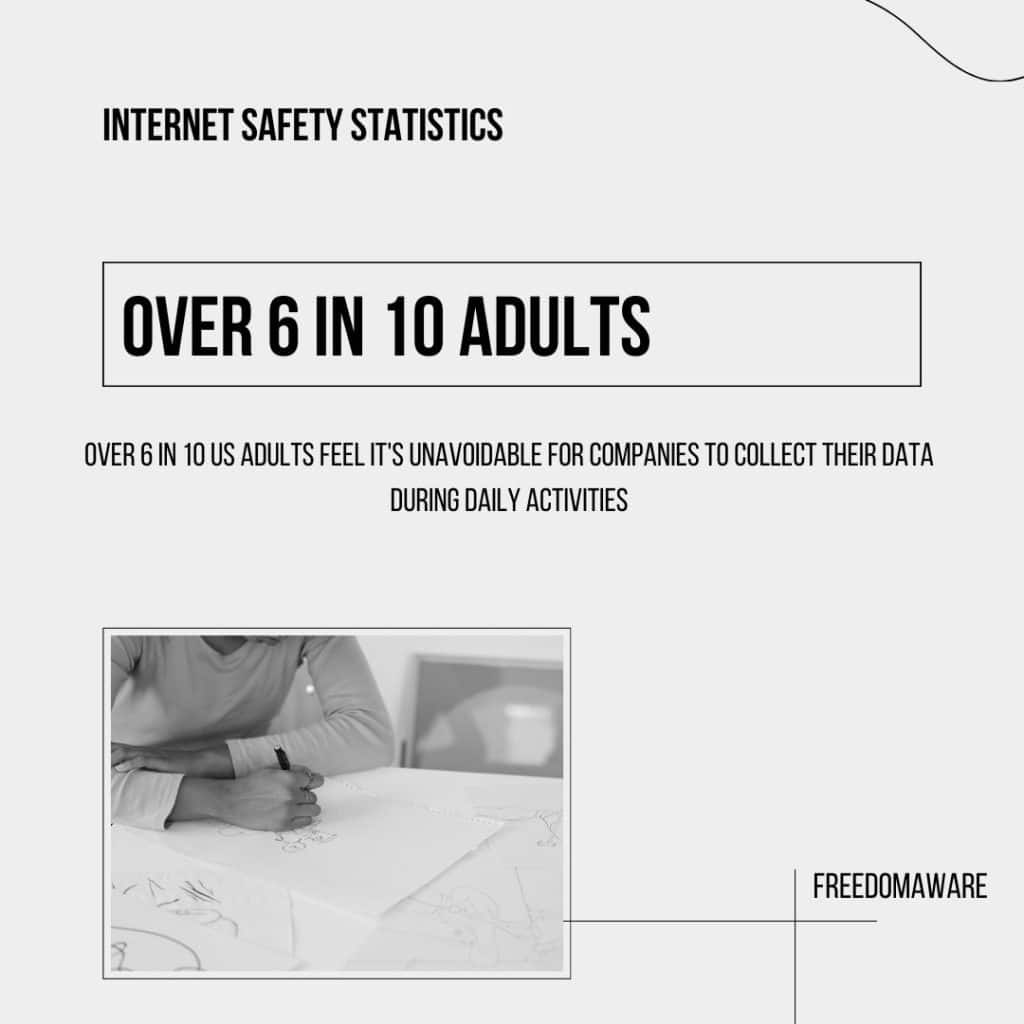
- Over 6 in 10 US adults feel it’s unavoidable for companies to collect their data during daily activities. (source)
- Limited Optimism: While 62% of US adults believe companies always collect data. (source)
- A smaller but significant portion (38%) remains hopeful about avoiding data collection in daily life. (source)
- Government Data Collection: Similar to concerns about companies, 63% of US adults feel the government inevitably collects their data. (source)
- while 36% believe some avoidance is possible. (source)
- Widespread Concern about Data Use: A large majority 81% in the US, expresses unease about how companies utilize collected data.(source)
- And 71% overall expresses unease about how companies utilize collected data. (source)
- Lack of Transparency: A significant knowledge gap exists, with 67% having little understanding of corporate data practices. (source)
- And an even larger percentage (77%) lacking knowledge of government data use. (source)
- Public Support for Regulation: The public overwhelmingly favors increased government regulation for online safety (72% in the US). (source)
- With minimal support for less regulation (7% in the US). (source)
- Internet dependence: The vast majority of teens (93%) rely on the internet for various purposes.(source)
Cybersecurity Landscape (internet safety statistics):
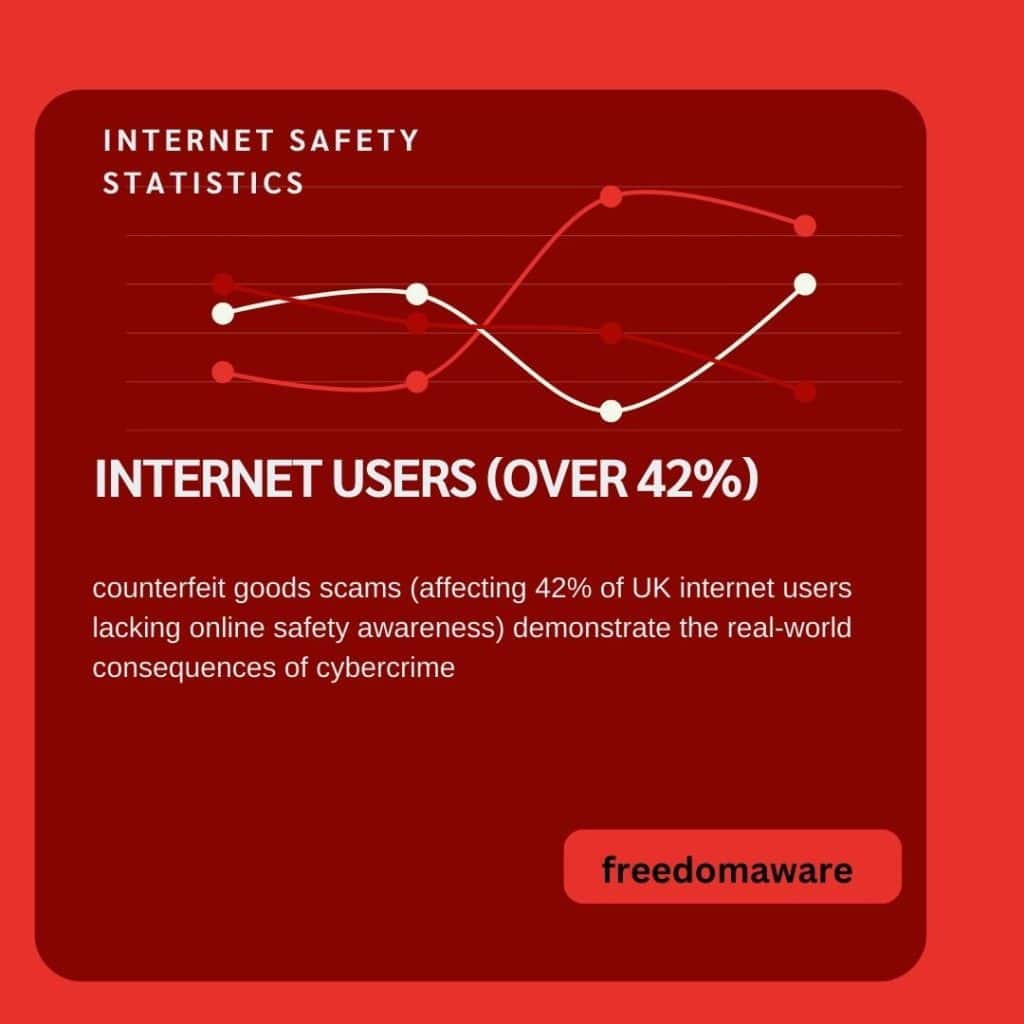
- Cybercrime Prevalence: Consumer fraud is a significant cyber threat, with nearly 31,000 cases reported in the US during Q2 2023. (source) This statistic highlights the importance of online vigilance.
- Impact of Online Scams: Examples like counterfeit goods scams (affecting 42% of UK internet users lacking online safety awareness) demonstrate the real-world consequences of cybercrime. (source)
- The Value of Connectivity: Despite security concerns, the internet offers undeniable benefits. A 2023 study revealed that 66% of UK internet users believe the advantages outweigh the drawbacks. (source)
- The Rise of Social Media: The COVID-19 pandemic fueled a surge in social media and messaging service use, with a 40% increase since 2020. This trend underscores our growing reliance on online communication. (source)
- A majority of children aged 10-12 (67%) and teenagers (76%) have encountered instances of bullying, whether as the aggressor, observer, or victim. (source)
- A significant portion of children aged 10-12 (58%) and teenagers (75%) have come across online content containing sexual information. (source)
- A substantial number of children aged 10-12 (58%) and teenagers (77%) have been exposed to internet content related to drugs and alcohol. (source)
- A considerable percentage of children aged 10-12 (68%) and teenagers (82%) have encountered online content depicting violence. (source)
- A minority of children aged 10-12 (8%) and teenagers (10%) have experienced predatory behavior from individuals online. (source)
- A notable proportion of children aged 10-12 (26%) and teenagers (38%) have been exposed to internet content related to depression. (source)
- A significant number of children aged 10-12 (33%) and teenagers (57%) have reported attempting suicide due to online information. (source)
- Approximately one in six individuals have experienced online sexual abuse before reaching the age of 18. (source)
- The vast majority of children aged 12-15 years (91%) have received guidance on internet safety from a parent. (source)
- A significant percentage of children aged 8-11 years (73%) have received instruction on internet safety from a teacher. (source)
- Two out of ten children aged 16-17 years (20%) have been educated about internet safety by law enforcement officials. (source)
- Millennials and Gen Zers are more likely to report experiencing a cyber threat, with 44% of millennials and 51% of Gen Zers compared to 21% of baby boomers. (source)
- Identity theft is more prevalent among millennials and Gen Zers, with 25% of millennials and 24% of Gen Zers having had their identities stolen, in contrast to only 14% of baby boomers. (source)
- The majority of baby boomers (79%) state that they have never encountered internet safety issues or fallen victim to cybercrime. (source)
- Security Habits: In the UK, only 7 out of 10 internet users secure their devices with strong passwords (source).
- Fingerprint or facial recognition is used for device access by over half (51%) of internet users (source).
- Privacy Habits: Among older UK citizens (aged 55+), 15% delete their browsing history and cookies daily (source).
- This is compared to only 11% of younger citizens (16-24) who regularly delete their browsing history and digital traces (source).
- Online Abuse: A majority (65%) of online abuse victims in the UK are dissatisfied with the response they receive from internet companies (source).
- Only 16% of victims report being happy with how their case was handled (source).
- VPN Usage: In the UK, a significant portion (27%) of citizens use virtual private networks (VPNs) for up to 20% of their browsing time (source).
- Even more extreme, 11% of UK citizens now browse the internet exclusively through VPNs (source).
- Privacy Concerns: When it comes to websites tracking their personal information, 30% of UK citizens feel skeptical, while 22% feel nervous about this practice (source).
- Cybercrime: A concerning statistic is that nearly 330 million people across 10 countries have been victims of cybercrime within the last year (source). This translates to a substantial number of people being impacted by cybercriminals.
- Impact of Cybercrime: The burden of cybercrime is significant. Victims spend an estimated 2.7 billion hours trying to resolve the issues caused by these attacks (source).
- Remote Work Risks: The perception of increased risk is strong, with 76% of people believing remote work makes them more susceptible to cybercrime (source).
- Post-Attack Actions: Most Americans (99%) who experience unauthorized access to an account or device take steps to improve their cybersecurity (source). This highlights a focus on improving online safety after a security breach.
- Security Measures: Strong passwords are a common response to cybercrime, with 66% of affected Americans adopting this practice (source).
- Seeking Help: When faced with cybercrime, victims often seek help from family (33%) or invest in additional security software (18%) (source).
- Privacy Concerns: Data privacy is a major concern for Americans, with a significant majority (88%) expressing worry (source).
- To combat this, 86% actively try to hide their online footprint (source).
- Safety Measures: People are taking action to protect themselves online. Stronger passwords are used by 55%, and 40% limit the information they share on social media (source).
- Knowledge Gap: A concerning knowledge gap exists, with 40% of Americans admitting they lack knowledge on how to protect themselves from cybercrime (source).
- Additionally, nearly half (46%) would be unsure of what to do if their identity was stolen (source).
- Parenting Challenges: The internet presents difficulties for parents. 70% of parents believe raising children is more complex today due to social media and unsafe online content (source).
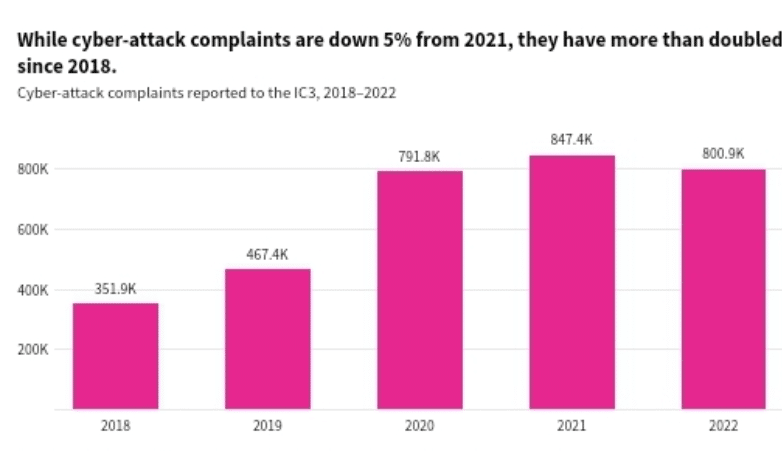
- Cybercrime Trends: There may be a slight decline in reported cybercrime. The number of reported cybercrimes in the US dipped to 800,944 in 2022, compared to 847,400 in 2021 (source). It’s important to note this might not reflect the true scale of the problem.
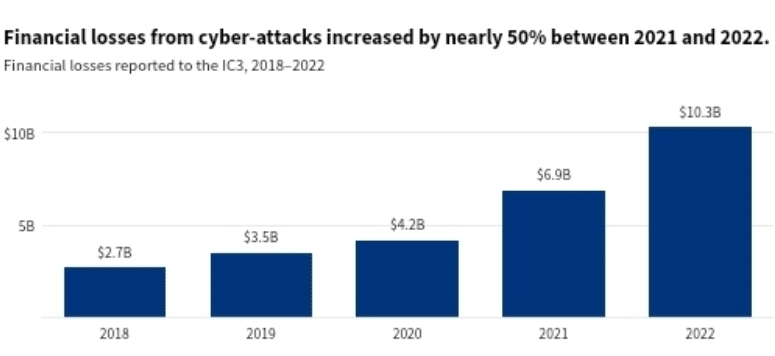
- Financial Impact of Cybercrime: Cybercrime is taking a significant financial toll. In 2022, there was a nearly 50% increase in financial losses, reaching $10.3 billion from $6.9 billion in the previous year (source).
- Phishing Dominates: Phishing attacks are the most common cybercrime, targeting a staggering 300,497 victims in 2022 and accounting for roughly 41% of all reported internet crimes (source).
- Age Group Targeted: Adults between 30 and 39 years old were the age group hit hardest by cybercrime in 2022, with 94,506 individuals reporting incidents (source).
- Investment Scams Costly: Fake investment scams were a major source of financial loss in 2022. These scams resulted in over $3.3 billion in lost assets, representing about one-third of total cybercrime losses (source).
- Cybersecurity Fears: A significant portion of Americans (59%) are concerned about falling victim to cybercrime (source). This highlights a general population awareness of the threat.
- Difficulties with Online Trust: Many Americans (56%) struggle to determine the credibility of information they encounter online (source). This highlights the challenge of navigating online information and avoiding misinformation.
- Social Media and Stalking: Social media is a prime hunting ground for cyberstalkers, with a staggering 82% using these platforms to gather information about their victims (source).
- Teens and Online Privacy: A significant portion of teens (32%) admit to hiding their browsing history, likely to shield their online activity from guardians (source). This statistic highlights potential privacy concerns among teenagers.
- Social Media Prevalence: A large majority of kids (73%) have social media accounts, making them potential targets online (source).
- Social Media and Stalking: Social media platforms are a major tool for cyberstalkers. A concerning 82% of cyberstalkers leverage these platforms to gather information about their victims (source). This information can be used to harass or endanger children.
- Location Risks: Social media use by children can expose personal details. A substantial portion of cyberstalkers (65%) use social media to discover a child’s location, such as where they live or attend school (source).
- Early Exposure: Even younger children are engaging with strangers online. A concerning 13% of kids in 2nd and 3rd grade have reported chatting with people they don’t know on the internet (source).
- Privacy Settings: There’s a mixed bag regarding privacy settings used by teens on social media. While 62% of teens take some steps towards privacy by making their Facebook accounts private, a significant minority (17%) leave all their information publicly available (source). This highlights the need for education on online safety and managing social media profiles.
- Privacy Efforts by Teens: Teens are taking steps to manage their online privacy from guardians. A significant portion (32%) admit to hiding their search history to conceal visited sites (source).
- Additionally, 16% confess to using secret social media or email accounts their parents are unaware of (source).
- Bypassing Parental Controls: A concerning statistic reveals that 11% of kids claim to know how to deactivate parental controls on their devices (source). This highlights the need for robust parental controls and open communication about online safety.
- Parental Awareness Gap: Teens may be successfully concealing online activity. A substantial number of kids (40%) report stopping their online activities if they suspect parental monitoring (source).
- Furthermore, 17% of kids believe their parents lack awareness of their online behavior (source). This suggests a gap in communication and the importance of open conversations about online safety.
- Widespread Witnessing: Cyberbullying is a significant online concern for teens. A staggering 90% of children have witnessed cyberbullying behavior in the past year (source).
- Increased Risk with Age: Teens become more likely to be involved in cyberbullying as they get older. Nationally, 33% of kids aged 12-17 report being victims, and the likelihood increases with age (source).
- Repeated Victimization: Many teens experience cyberbullying repeatedly. Around 25% of kids report being bullied online more than once, and 40% have encountered hurtful comments online on multiple occasions (source).
- Smartphones and Social Media: Smartphones are the primary platform for cyberbullying, unsurprising given that 80% of teens use them regularly (source). Anonymity and ease of access likely contribute to this trend.
- Perceived Ease: Teens overwhelmingly believe that bullying is easier online, with 81% reporting this view (source). This perception may embolden bullies and make intervention more difficult.
- Bystander Silence: A concerning statistic reveals that 90% of teens who witness cyberbullying on social media do not intervene (source). This highlights the need to encourage bystander action against online harassment.
- Limited Parental Reporting: Teens are reluctant to report cyberbullying to parents. Only 10% of teens will inform a parent if they are being bullied online (source). This creates a communication gap and makes it harder to address the issue.
- Disproportionate Impact: Girls are twice as likely to experience cyberbullying compared to boys (source). This highlights the need for targeted support and awareness campaigns.
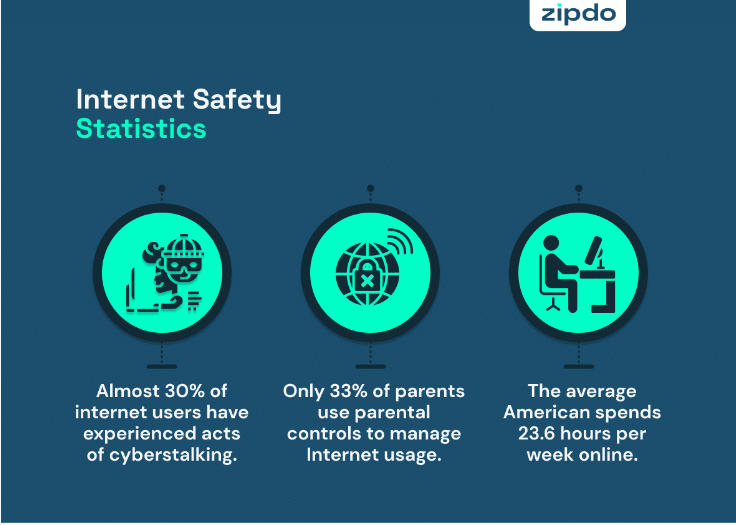
Privacy Concerns on the Rise (internet safety statistics)
More than half of internet users are hitting the brakes on online sharing. Events like the Yahoo hack, the GDPR regulations, and even the COVID-19 pandemic have all put a spotlight on online privacy. This growing concern underscores the need for better education about cyber threats and the tools available to keep our digital lives secure.
Data Woes (internet safety statistics): Half Lost in the Mix
A whopping 50% of American adults feel uneasy about the amount of personal information floating around online. To make matters worse, nearly half (47%) aren’t sure what happens to their data once it’s collected. This information gap leaves many vulnerable to online dangers like scams, identity theft, and other malicious activities. It’s clear we need to bridge this knowledge gap and empower people to protect their digital lives.
Email (internet safety statistics): Hotbed for Hidden Threats
Did you know? A whopping 94% of malware lurks in emails! This stat is a wake-up call to treat every email with a healthy dose of suspicion. Even seemingly harmless messages could be packing a malicious punch. Remember, the internet isn’t always sunshine and rainbows. Stay sharp and play it safe when navigating your inbox.
The Takeaway (internet safety statistics): Safeguard Your Online World
The numbers paint a clear picture: the internet can be a minefield. But fear not! By understanding the risks and taking steps to protect yourselves, you and your family can navigate the digital world with confidence. Let’s turn these alarming statistics into a call to action for online safety.
Internet Safety: Your Digital Defense Guide
What’s Lurking Online?
The internet is a vast and wonderful place, but it also comes with hidden dangers. Here’s a quick rundown of the top threats:
- Scammers on the Hunt: Watch out for online cons designed to steal your money or personal information.
- Cyberbullies Run Amok: Unfortunately, online harassment can be a real problem.
- Inappropriate Content Around the Corner: The internet can be a Wild West, so be mindful of what you or your family might encounter.
- Identity Theft: A Nightmare Scenario: Criminals might try to steal your personal details for malicious purposes.
- Phishing for Trouble: Don’t fall for fake emails or websites trying to trick you into giving away personal information.
Arm Yourself for the Digital Age
Knowledge is power! Here are some essential internet safety rules:
- Password Power: Create strong and unique passwords for all your accounts.
- Double the Security: Enable multi-factor authentication (MFA) whenever possible for an extra layer of protection.
- Think Before You Click: Only visit websites that look trustworthy and avoid suspicious links.
- Privacy Matters: Review your privacy settings on social media and other platforms. Don’t blindly accept privacy policies – take a moment to read them!
- Backup Regularly: Save copies of your important data to avoid losing it.
- Clean Up Your Digital Footprint: Close old accounts you no longer use.
What is Internet Safety?
Think of internet safety as your digital shield. It’s all about protecting your data and personal information from unauthorized access or misuse.
Phishing: Don’t Get Hooked
Phishing scams are like online bait-and-switch tactics. Scammers use fake emails or websites to trick you into revealing your personal information, like passwords or credit card details.
Stay Phish-Free
- Be cautious of websites without “HTTPS” in the address bar – this indicates a secure connection.
- Strong passwords are your best defense.
- Don’t open emails from unknown senders, and delete suspicious messages immediately.
- Use anti-virus software to help identify and block potential threats.
How Hackers Get In
Hackers and malicious actors use various tricks to gain access to your data. These can be hidden in emails, fake downloads, or even seemingly harmless websites. By following these tips, you can significantly reduce the risk of falling victim to these tactics.
The Bottom Line (internet safety statistics)
The internet offers a treasure trove of information and connections, but it’s not without its pitfalls. These internet safety statistics would be a guide to navigate it safely. We need to be smart about what we share and how we connect. This includes being cautious with social media, online banking, and any personal information we reveal. Remember, the devices we use are gateways, and we need to secure them properly. Don’t wait for trouble to find you; take steps to stay protected from the start.

